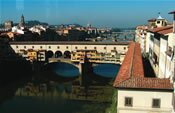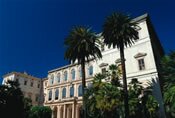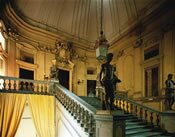Inflight Magazine of Brussels Airlines
Welcome to the Inflight Magazine of Brussels Airlines
Hidden Florence
Image Lonely Planet Images
With a little bit of forward planning, you can enjoy the secret joys of Florence well away from the tourist crowds. Adrian Mourby uncovers the best on offer
 Info Dial for Italy
Info Dial for Italy
My guide Roberto Martelli – bearded, dapper and speaking excellent American English – was guiding me through Florence’s Galleria degli Uffizi one winter morning when he realised it was time for ‘the appointment’. The Uffizi is one of the world’s great art galleries, a Disney World for lovers of the Italian Renaissance.
All the favourite stars are here – Sandro Botticelli, Leonardo da Vinci and Michelangelo. The only problem is, you have to share them with everyone else. ‘The appointment’, however, was something I wouldn’t have to share with anyone.
At 11am sharp, a tall wooden door on the top floor of the Uffizi opened and Roberto and I stepped through. If you’d passed the door – as I had done before – you’d assume it led to an office or the room where they kept unsold postcards. It doesn’t. The door admitted Roberto, me and a security guard into a silent world. Steep stone steps, carpeted in a rich grey runner, led down to Corridoio Vasariano, or the Vasari Corridor. The Medicis walked it on a daily basis, Hitler visited in 1938 and Marc Chagall came here when he was made an honorary citizen of Florence in 1984.
 The Vasari Corridor is a private passageway that leads from the Uffizi in the centre of Florence, over the Arno River across the top of Ponte Vecchio and into Palazzo Pitti. It was built so Cosimo de’ Medici, also known as Cosimo the Great, could walk from his palace to his offices in the city state he governed without having to mix with the murderous plebs. The 1km long corridor, designed by Giorgio Vasari, was built in just five months in 1565.
The Vasari Corridor is a private passageway that leads from the Uffizi in the centre of Florence, over the Arno River across the top of Ponte Vecchio and into Palazzo Pitti. It was built so Cosimo de’ Medici, also known as Cosimo the Great, could walk from his palace to his offices in the city state he governed without having to mix with the murderous plebs. The 1km long corridor, designed by Giorgio Vasari, was built in just five months in 1565.
At the time, the plebs weren’t at all happy with Cosimo, who had grown tired of being just Florence’s banker. He wanted to be Grand Duke of Tuscany too and, once duke, really didn’t want to be assassinated. To get Cosimo to work safely each day, Vasari built a sealed corridor from one side of the Arno to the other, demolishing existing buildings when he could and skirting around them when he couldn’t. That it happened so quickly is extraordinary; that it looks so beautiful is beyond belief.
You can’t just wander into the Vasari Corridor. You have to apply at least one month in advance and be accompanied by a security guy, like our Michelangelo, who was there to make sure I didn’t damage or steal any pictures. That’s the other remarkable thing about the Vasari Corridor – in the 19th century, when there were no more Medicis left to assassinate, it was turned into an overspill art gallery for the Uffizi.
 At the bottom of the steps, we turned a corner and came face to face with more than 700 self-portraits.
At the bottom of the steps, we turned a corner and came face to face with more than 700 self-portraits.
The Medicis collected self-portraits by everyone from Tintoretto to Jan van Eyck and Élisabeth-Louise VigéeLe Brun, one of France’s first female painters. When the collection passed to the state, the corridor – hitherto just a thoroughfare – became the world’s premiere gallery for self-portraiture. First up is Vasari himself, painter, architect and writer – a true Renaissance man.
As we passed over the tops of shops on Ponte Vecchio, Roberto drew my attention to ‘Cosimo’s eyes’, the round barred windows that allowed the paranoid duke to spy on his subjects.
At the halfway point along the bridge are nine large picture windows that look west down the Arno to the three bridges that had to be rebuilt after the Wehrmacht withdrew in 1944. Ponte Vecchio – and the corridor – would have been destroyed too in an attempt to impede the Allied advance, but Hitler sent word from Berlin that it was not to be touched. He had fond memories of the nine windows, which were inserted on Mussolini’s orders so the Führer had a good view from the corridor when he visited Florence in 1938.
Down below I could see people shopping for gold on Ponte Vecchio, unaware of our presence. In 1565, the Medicis objected to the smell of the butchers’ shops on the bridge as they passed along their new passageway, so the butchers were moved out and replaced by goldsmiths, who are still there today. “No one can object to the smell of gold,” a family member is said to have quipped.
 Once across the bridge, Roberto and I followed a dog-leg diversion around the Mannelli Tower. Most buildings in the way of the corridor were bought up and knocked through by Vasari, but the owner of this tower refused permission, so the passage had to be diverted around the outside, like a car going round a cliff edge on just one set of wheels. The people of Florence wondered what the punishment would be for such stubbornly behaviour, but Cosimo said magnanimously: “Everyone is the patron of his own house.”
Once across the bridge, Roberto and I followed a dog-leg diversion around the Mannelli Tower. Most buildings in the way of the corridor were bought up and knocked through by Vasari, but the owner of this tower refused permission, so the passage had to be diverted around the outside, like a car going round a cliff edge on just one set of wheels. The people of Florence wondered what the punishment would be for such stubbornly behaviour, but Cosimo said magnanimously: “Everyone is the patron of his own house.”
At the end of the gallery is a wedding portrait of Anna Maria Luisa de’ Medici, last of the Medicis, who willed the family’s art collection to the people of Florence on her death in 1743. We have her to thank for the richness of the Uffizi but also for this 16th-century service tunnel, which is a revelation.
 When we emerged into the grounds of Palazzo Pitti, I asked Roberto if there were any more hidden treats like this in Florence. “Over there,” he said, gesturing down Via Romana. “If you turn right you’ll come to Casa Guidi, the house where Elizabeth Barrett Browning lived.
When we emerged into the grounds of Palazzo Pitti, I asked Roberto if there were any more hidden treats like this in Florence. “Over there,” he said, gesturing down Via Romana. “If you turn right you’ll come to Casa Guidi, the house where Elizabeth Barrett Browning lived.
Many mementoes.
Of course, you have to telephone in advance to be shown round.”
This is the deal in Florence. There are the well-known sites – the Duomo, Uffizi, Galleria dell’Accademia and Palazzo Pitti – which are open almost daily and usually packed with tourists. But if you want to see the hidden side of Florence it takes time, phone calls and planning – or the services of a good agency.
 Galleria Corsini (Palazzo Corsini, 11 Via del Parione, tel. ) is housed in one of the grandest family-owned palaces on the banks of the Arno River. The Corsinis were Florentine wool merchants who made their fortune in the 13th century. As members of the popolo grasso (rich merchant class), they ruled Florence during the later Middle Ages before the Medicis consolidated power in their own hands. Galleria Corsini contains the family’s private collection of 17thand 18th-century art. Admission is by appointment only.
Galleria Corsini (Palazzo Corsini, 11 Via del Parione, tel. ) is housed in one of the grandest family-owned palaces on the banks of the Arno River. The Corsinis were Florentine wool merchants who made their fortune in the 13th century. As members of the popolo grasso (rich merchant class), they ruled Florence during the later Middle Ages before the Medicis consolidated power in their own hands. Galleria Corsini contains the family’s private collection of 17thand 18th-century art. Admission is by appointment only.
In the Medici chapel in Basilica di San Lorenzo (6 Piazza Madonna degli Aldobrandini, ) there’s the sotteraneo, where Michelangelo hid during the French siege in 1529-30. The sketches and doodles he drew on the wall during this time have recently been uncovered and give us a clearer idea of the artist’s mind than some of his more famous works elsewhere in the city. Appointments are required here, too, because of the confined space.
 More curious still is Cappella del Santo Sepolcro (18 Via della Spada), just behind Corsini Palace. From the outside it looks like an abandoned building, but inside there’s a replica of Jerusalem’s Church of the Holy Sepulchre. It’s only open on Saturdays at 5.30pm and from July to September it doesn’t open at all, so time your visit well.
More curious still is Cappella del Santo Sepolcro (18 Via della Spada), just behind Corsini Palace. From the outside it looks like an abandoned building, but inside there’s a replica of Jerusalem’s Church of the Holy Sepulchre. It’s only open on Saturdays at 5.30pm and from July to September it doesn’t open at all, so time your visit well.
Abercrombie & Kent (www.abercrombiekent.co.uk) can arrange visits to the Vasari Corridor for €360 for groups of 10. Italian company Florence Art (www.florenceart.it) also organises visits for groups of 10 to 25 people. Adrian Mourby stayed at Hotel Helvetia & Bristol (2 Via dei Pescioni, , helvetia www.bristol.warwickhotels.com.
FR Florence secrète
La galerie des Offices est l’une des plus grandes galeries d’art au monde, on y trouve des collections uniques des oeuvres de Botticelli, de Léonard de Vinci et de Michel-Ange. Le seul problème est que vous devez les partager avec tous les autres visiteurs.
Toutefois, au dernier étage des Offices, vous passez par une porte qui vous emmène dans un monde secret. Un escalier aux marches raides descend vers le Corridoio Vasariano, un passage privé qui conduit des Offices au-dessus du Ponte Vecchio, dans le Palazzo Pitti. Il a été construit pour que Cosme de Médicis puisse rejoindre ses appartements sans devoir se mélanger à la foule. Le corridor d’1 km, conçu par Giorgio Vasari, a été construit en cinq mois en 1565.
Pour entrer dans le Corridoio Vasariano, vous devez introduire la demande un mois à l’avance. Depuis le 19è siècle, le corridor a servi d’espace d’exposition supplémentaire pour les Offices, abritant aujourd’hui plus de 700 autoportraits.
A mi-chemin, le long du Ponte Vecchio, neuf larges baies donnent sur le fleuve Arno. Elles ont été introduites sous ordre de Mussolini afin qu’Hitler puisse jouir d’une magnifique vue panoramique à l’occasion de sa visite en 1938.
Corridoio Vasariano n’est certainement pas le seul joyau caché de Florence. Les Galeries Corsini (Palazzo Corsini, 11 Via del Parione) hébergent la collection d’art privée des 17 e et 18 e siècles de la famille Corsini. Les visites ne sont organisées que sur rendez-vous. Dans la chapelle des Médicis, dans la Basilique de San Lorenzo (6 Piazza Madonna degli Aldobrandini) un souterrain connu sous le nom de sotteraneo est le lieu où Michel-Ange s’est caché durant le siège français de Florence en 1529-30, et où il a laissé des dessins et des esquisses sur le mur. Ici aussi une réservation est nécessaire.
Encore plus étrange est la Cappella del Santo Sepolcro (18 Via della Spada), une réplique du Saint-Sépulcre de l’Eglise de Jérusalem. L’accès est limité aux samedis à 17.30h, et de juillet à septembre, l’Eglise est tout à fait inaccessible. Vous devez donc prendre cet élément en compte lorsque vous planifiez votre séjour.
NL Ongekend Firenze
Het Uffizi is een van ’s werelds topmusea, met meesterwerken van Botticelli, Leonardo da Vinci en Michelangelo. Helaas wil iedereen ze zien.
Achter een deur op de hoogste verdieping schuilt gelukkig een verborgen wereld. Een steile, stenen trap leidt je naar de Corridoio Vasariano, een privégang die van het Uffizi over de Ponte Vecchio naar het Palazzo Pitti loopt. Ze werd gebouwd voor Cosimo de’ Medici, zodat hij zich op weg naar zijn kantoor niet onder het gepeupel hoefde te mengen. Giorgio Vasari ontwierp de 1 km lange corridor in 1565, en de bouw duurde vijf maanden.
Wie de Corridoio Vasariano wil bezoeken, moet ten minste een maand vooraf een aanvraag indienen. Beslist de moeite, want sinds de 19de eeuw fungeert de corridor als extra galerij voor het Uffizi, en herbergt ondertussen al meer dan 700 zelfportretten.
Halverwege de Ponte Vecchio geven negen vensters uit op de rivier de Arno. Mussolini liet ze plaatsen opdat Hitler een mooi zicht zou hebben tijdens zijn bezoek in 1938.
De Corridoio Vasariano is niet de enige verborgen parel in Firenze. De Galleria Corsine (Palazzo Corsini, 11 Via del Parione, alleen toegankelijk op afspraak) huisvest 17de- en 18deeeuwse kunst uit de privécollectie van de familie Corsini. In de Medicikapel van de Basilica di San Lorenzo (6 Piazza Madonna degli Aldobrandini) is er een gang die bekend staat als de sotteraneo. Tijdens de Franse belegering van Firenze in 1529-30 hield Michelangelo zich daar schuil, getuige zijn tekeningen op de muren. Ook hier is reserveren verplicht.
Helemaal bijzonder is de Cappella del Santo Sepolcro (18 Via della Spada), een kopie van de Basiliek van het Heilig Graf in Jeruzalem. Uitsluitend op zaterdag om 17.30 u. te bezoeken en van juli tot september is ze zelfs helemaal gesloten. Plan je bezoek dus goed!
Leave a Reply
